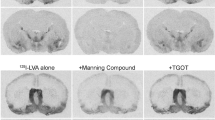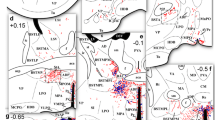Abstract
Oxytocin (OT) and arginine vasopressin (AVP) are produced in the brain. Due to their importance in modulating social behaviour, these two neuropepetides have been extensively studied in captivity, yet few data are available from the field. Here we report the findings from an immunohistochemistry study, where we measured density of OT and AVP in different brain nuclei of wild African striped mice (Rhabdomys pumilio). Striped mice are socially flexible with both sexes being able to follow alternative reproductive tactics. Adult males can remain natally philopatric, or they can disperse and live solitarily as roamers or immigrate into a group and become breeders. Previous studies in captivity found no differences between solitary and group-living striped mice in AVPR1a expression, but solitary males had higher irAVP concentrations in the paraventricular nucleus and BNST. In the present study we tested whether the results obtained from captive studies could be replicated in the wild. We collected brains from 5 breeders, 9 philopatrics, and 3 roamers from a field site in South Africa and transported them to the USA for immunohistochemistry. Our results showed that roamers have higher irAVP concentrations in the BNST than philopatrics, which leads us to predict for future experimental studies that roamers will be able to increase AVP secretion in the brain when becoming group-living.

Similar content being viewed by others
References
Anacker AM, Beery AK (2013) Life in groups: the roles of oxytocin in mammalian sociality. Front Behav Neurosci 7:185
Bales KL, Kramer KM, Lewis-Reese AD, Carter CS (2006) Effects of stress on parental care are sexually dimorphic in prairie voles. Phys Behav 87:424
Beery AK, Lacey EA, Francis DD (2008) Oxytocin and vasopressin receptor distributions in a solitary and a social species of tuco-tuco (Ctenomys haigi and Ctenomys sociabilis). J Comp Neurol 507:1847
Brown RE (1993) Hormonal and experiential factors influencing parental behaviour in male rodents: an integrative approach. Behav Process 30:1
Caldwell HK, Lee H, Macbeth AH, WSY III (2008) Vasopressin: behavioral roles of an “original” neuropeptide. Prog Neurobiol 84:1
Carter CS (1998) Neuroendocrine perspectives on social attachment and love. Psychoneuroendocrinology 23:779
Cushing BS, Martin JO, Young LJ, Carter S (2001) The effects of peptides on partner preference formation are predicted by habitat in prairie voles. Horm Behav 39:48
Dantzer R, Koob GF, Bluthe RM, Moal ML (1988) Septal vasopressin modulates social memory in male rats. Brain Res 457:143–147
Ferris CF, Meenan DM, Axelson JF, Albers HE (1986) A vasopressin antagonist can reverse dominant/subordinate behavior in hamsters. Physiol Behav 38:135–138
Goodson JL, Kabelik D (2009) Dynamic limbic networks and social diversity in vertebrates: from neural context to neuromodulatory patterning. Front Neuroendocrinol 30:429
Grippo AJ, Gerena D, Huang J, Kumar N, Shab M, Ughreja R, Carter S (2007) Social isolation induces behavioral and neuroendocrine disturbances relevant to depression in female and male prairie voles. Psychoneuroendocrinology 32:966–980
Heckel G, Fink S (2008) Evolution of the arginine vasopressin 1a receptor and implications for mammalian social behaviour. Prog Brain Res 170:321
Heimann M, Kasermann HP, Pfister R, Roth DR, Burki K (2009) Blood collection from the sublingual vein in mice and hamsters: a suitable alternative to retrobulbar technique that provides large volumes and minimizes tissue damage. Lab Anim 43:255
Kenkel WM, Paredes J, Yee RJ, Pournajafi-Nazarloo H, Bales KL, Carter CS (2012) Neuroendocrine and behavioural responses to exposure to an infant in male prairie voles. J Neuroendocrinol 24:874–886
Kenkel WM, Suboc G, Carter CS (2014) Autonomic. Behavioral and neuroendocrine correlates of paternal behavior in male prairie voles, Phys Behav
Landgraf R, Wotjak CT, Neumann ID, Engelmann M (1998) Release of vasopressin within the brain contributes to neuroendocrine and behavioral regulation. Prog Brain Res 119:201
Lee HJ, Macbeth AH, Pagani JH, Young WS (2009) Oxytocin: the great facilitator of life. Prog Neurobiol 88:127–151
Leigh SR (2004) Brain growth, life history, and cognition in primate and human evolution. Am J Primatol 62:139
Morris M, Stevens SW, Adams MR (1980) Plasma oxytocin during pregnancy and lactation in the cynomolgus monkey. BOR 23:782–787
Ophir AG, Campbell P, Hanna K, Phelps SM (2008a) Field tests of cis-regulatory variation at the prairie vole avpr1a locus: association with V1aR abundance but not sexual or social fidelity. Horm Behav 54:694
Ophir AG, Wolff JO, Phelps SM (2008b) Variation in neural V1aR predicts sexual fidelity and space use among male prairie voles in semi-natural settings. Proc Natl Acad Sci USA 105:1249
Ophir AG, Gessel A, Zheng DJ, Phelps SM (2012) Oxytocin receptor density is associated with male mating tactics and social monogamy. Horm Behav 61:445
Raynaud J, Schradin C (2014) Corticosterone levels correlate with alloparental care in a sex-dependent manner in African striped mice, Rhabdomys pumilio. Ethology 121:57–67
Sawchenko PE, Swanson LW (1982) Immunohistochemical identification of neurons in the paraventricular nucleus of the hypothalamus that project to the medulla or to the spinal cord in the rat. J Comp Neurol 205:260
Schoepf I, Schradin C (2012a) Better off alone! Reproductive competition and ecological constraints determine sociality in the African striped mouse (Rhabdomys pumilio). J Anim Ecol 81:649
Schoepf I, Schradin C (2012b) Differences in social behaviour between group-living and solitary African striped mice Rhabdomys pumilio. Anim Behav 84:1159
Schradin C (2008a) Differences in prolactin levels between three alternative male reproductive tactics in striped mice (Rhabdomys pumilio). Proc R SocB 275:1047
Schradin C (2008b) Seasonal changes in testosterone and corticosterone levels in four social categories of a desert dwelling sociable rodent. Horm Behav 53:573
Schradin C, Lindholm AK (2011) Relative fitness of alternative male reproductive tactics in a mammal varies between years. J Anim Ecol 80:908
Schradin C, Pillay N (2003) Paternal care in the social and diurnal striped mouse (Rhabdomys pumilio): laboratory and field evidence. J Comp Psychol 117:317
Schradin C, Pillay N (2014) Absence of reproductive suppression in young adult female striped mice living in their natal family. Anim Behav 90:141–148
Schradin C, Yuen CH (2011) Hormone levels of male African striped mice change as they switch between alternative reproductive tactics. Horm Behav 60:676
Schradin C, Scantlebury M, Pillay N, König B (2009a) Testosterone levels in dominant sociable males are lower than in solitary roamers: physiological differences between three male reproductive tactics in a sociably flexible mammal. Am Nat 173:376
Schradin C, Schneider C, Yuen CH (2009b) Age at puberty in male African striped mice: the impact of food, population density and the presence of the father. Funct Ecol 23:1004–1013
Schradin C, Schneider C, Lindholm AK (2010) The nasty neighbour in the striped mouse (Rhabdomys pumilio) steals paternity and elicits aggression. Front Zool 7:19
Schradin C, Eder S, Müller K (2012) Differential investment into testes and sperm production in alternative male reproductive tactics of the African striped mouse (Rhabdomys pumilio). Horm Behav 61:686
Schradin C, Kenkel W, Krackow S, Carter C (2013) Staying put or leaving home: endocrine, neuroendocrine and behavioral consequences in male African striped mice. Horm Behav 63:136
Schradin C, Larke RH, Bales KL (2014) Growing up in the family or growing up alone influences behavior and hormones, but not arginine vasopressin receptor 1a expression in male African striped mice. Phys Behav 129:205
Solomon NG, Richmond AR, Harding PA, Fries A, Jacquemin S, Schaefer RL, Lucia KE, Keane B (2009) Polymorphism at the avpr1a locus in male prairie voles correlated with genetic but not social monogamy in field populations. Mol Ecol 18:4680
Winslow JT, Hastings N, Carter CS, Harbaugh CR, Insel TR (1993) A role for central vasopressin in pair bonding in monogamous prairie voles. Nature 365:545–548
Young L (2009) Love: neuroscience reveals all. Nature 457:148
Young LJ, Nilsen R, Waymire KG, MacGregor GR, Insel TR (1999) Increased affiliative response to vasopressin in mice expressing the V1a receptor from a monogamous vole. Nature 400:766
Acknowledgments
We thank the Department of Tourism, Environment and Conservation of the Northern Cape for research permits, and the manager and staff of the Goegap Nature Reserve for their support. This study was made possible by the administrative and technical support of the Succulent Karoo Research Station (registered South African NPO 122-134), at which field site the data were collected. For help in the field, we thank C.H. Yuen (Research Station Manager). We are thankful to C.S. Carter for important comments. Funding was provided by the Swiss National Science Foundation (31003A-135770/1). Animal ethical clearance was provided by the University of the Witwatersrand, Johannesburg, South Africa (No. 2004/87/2A, 2005/82/4, and 2006/3/03).
Author information
Authors and Affiliations
Corresponding author
About this article
Cite this article
Schoepf, I., Kenkel, W. & Schradin, C. Arginine vasopressin in brains of free ranging striped mouse males following alternative reproductive tactics. J Ethol 33, 235–242 (2015). https://doi.org/10.1007/s10164-015-0436-6
Received:
Accepted:
Published:
Issue Date:
DOI: https://doi.org/10.1007/s10164-015-0436-6




